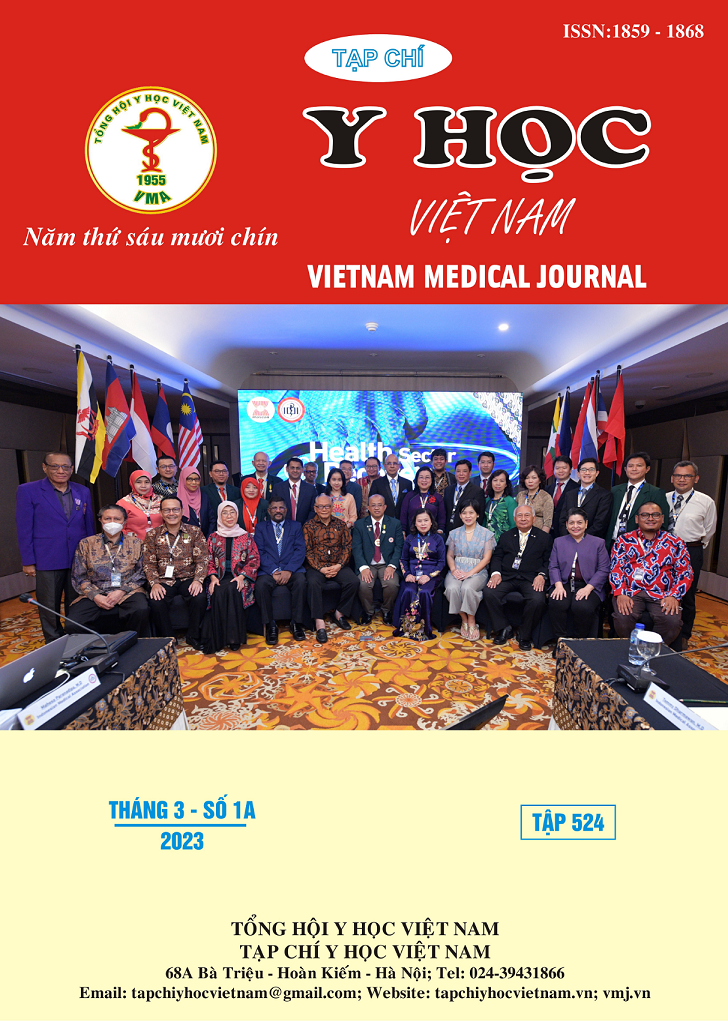INVESTIGATE THE ROLE OF CAGPAI OF HELICOBACTER PYLORI IN GASTRIC CANCER PATIENTS
Main Article Content
Abstract
Background: Many studies have found that the intactness of H. pylori's cag pathogenicity island (cagPAI) is associated with gastric cancer (GC) risk, however the results are inconsistent. Aim: This research aims to investigate the relationship between H. pylori’s cagPAI intactness and the risk of GC in Vietnam. Subjects and methods: A cross-sectional study of 179 patients with H. pylori infection, in which 89 patients with gastric cancer and 90 patients with chronic gastritis (CG). Diagnosis of GC and CG is based on histopathology. CagPAI status was determined through the present or absent of three genes cagA, cagE, cagT by realtime-PCR technique. Results: 100% of H. pylori strains carried cagPAI gene, in which the rate of H. pylori carrying the intact cagPAI was 70.4%. The GC group had a higher rate of intact cagPAI than the CG group (79.8% vs 61.1%), the difference was statistically significant (OR = 2.5; p < 0.01). In gastric cancer patients: There was no difference in the prevalence of H. pylori carrying the cagPAI gene by age group, gender, macroscopic characteristics on endoscopy (according to Borrmann classification) and on histopathology (according to the Borrmann classification). Lauren's classification). Conclusion: The intact cagPAI of H. pylori is associated with the risk of gastric cancer in Vietnam.
Article Details
Keywords
cagPAI, Helicobacter pylori, gastric cancer, chronic gastritis
References
2. Kusters Johannes G, Arnoud HM Van Vliet, and Ernst J Kuipers (2006), "Pathogenesis of Helicobacter pylori infection", Clinical microbiology reviews. 19(3), p. 449-490.
3. Fischer Wolfgang, Jürgen Püls, Renate Buhrdorf, et al (2001), "Systematic mutagenesis of the Helicobacter pylori cag pathogenicity island: essential genes for CagA translocation in host cells and induction of interleukin‐8", Molecular microbiology. 42(5), p. 1337-1348.
4. Ikenoue T., S. Maeda, K. Ogura, et al (2001), "Determination of Helicobacter pylori virulence by simple gene analysis of the cag pathogenicity island", Clin Diagn Lab Immunol. 8(1), p. 181-186.
5. Khatoon J, KN Prasad, R Prakash Rai, et al (2017), "Association of heterogenicity of Helicobacter pylori cag pathogenicity island with peptic ulcer diseases and gastric cancer", Br J Biomed Sci. 74(3), p. 121-126.
6. Day Andrew S, Nicola L Jones, Jennifer T Lynett, et al (2000), "cagE Is a Virulence Factor Associated with Helicobacter pylori—Induced Duodenal Ulceration in Children", The Journal of infectious diseases. 181(4), p. 1370-1375.
7. Mattar Rejane, Sergio Barbosa Marques, Maria do Socorro Monteiro, et al (2007), "Helicobacter pylori cag pathogenicity island genes: clinical relevance for peptic ulcer disease development in Brazil", Journal of medical microbiology. 56(1), p. 9-14.
8. Nguyen LT, T Uchida, Y Tsukamoto, et al (2010), "Clinical relevance of cagPAI intactness in Helicobacter pylori isolates from Vietnam", European journal of clinical microbiology infectious diseases. 29(6), p. 651-660.
9. Nilsson C., A. Sillén, L. Eriksson, et al (2003), "Correlation between cag pathogenicity island composition and Helicobacter pylori-associated gastroduodenal disease", Infect Immun. 71(11), p. 6573-6581.
10. Amieva M. and R. M. Peek, Jr. (2016), "Pathobiology of Helicobacter pylori-Induced Gastric Cancer", Gastroenterology. 150(1), p. 64-78.


